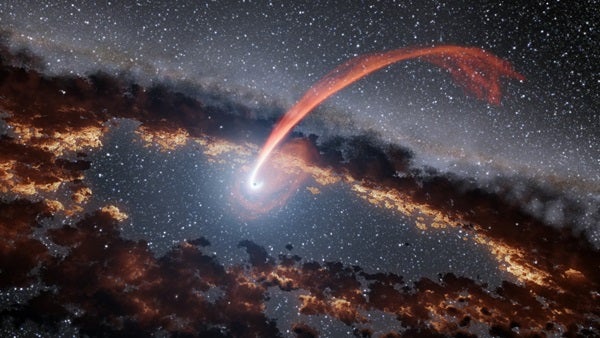When a star passes close enough to a black hole, the black hole’s gravitational pull on the near side of the star can overcome the internal gravity holding the star together. The result is a stream of stellar matter spiraling toward the black hole. As a clump of stellar matter approaches the black hole, it heats up and emits what is known as a tidal disruption flare of energetic radiation.
It is difficult to see what is happening within one of these stellar tidal disruption events, but astronomers have found a new method of seeing inside a tidal disruption flare by looking not at the flare itself but at its effects on the dust surrounding the black hole.
For the first time, a team led by astrophysicists from Johns Hopkins University has observed the “echo” of a tidal disruption flare re-emitted by the dust around the black hole.
“The flare can emit optical, UV, extreme UV, and X-rays,” says Sjoert van Velzen, a postdoctoral fellow at Johns Hopkins and lead author of the paper. “The optical and near UV are (relatively) easy to observe, but the extreme UV emission gets absorbed [by neutral hydrogen] as the photons travel through the host galaxy of the flare and through our Milky Way galaxy. So before reaching our telescopes or satellites, all the extreme-UV emission is gone.”
Velzen and three colleagues analyzed data compiled by the Wide-field Infrared Survey Explorer (WISE), which NASA launched into Earth’s orbit in 2009. They studied five tidal disruption events — each of which can unfold over a period of months — from the otherwise inactive supermassive black holes in the center of five galaxies, the closest of which is 840 million light-years from Earth. They published their findings in the Sept. 15, 2016, issue of Astrophysical Journal.
The intense radiation from the flare destroys any interstellar dust within 2 trillion miles of the black hole, according to Velzen’s calculations. Dust that is not vaporized, just outside the 2 trillion-mile radius, absorbs visible, UV, and soft X-ray light and re-emits it at an infrared wavelength of about 3.4 microns. The radius of dust destruction depends on the size and composition of the dust surrounding the black hole. Velzen estimates the dust is “carbon-like” with a typical size of about 1 micron.
The infrared emission from dust heated by a tidal disruption flare can be detected up to a year after the peak of the flare.
Identifying tidal disruption flares is tricky to begin with. Only two or three dozen such events have been recorded. When astronomers see an energetic explosion somewhere in the universe, they have to distinguish it as a tidal disruption flare as opposed to an outburst from an active galactic nucleus (AGN) or a supernova.
“Ultimately, observers find themselves looking for a few key characteristics — high optical/UV/X-ray luminosity, proximity to the dead center of a galaxy, where supermassive black holes reside — and then try to rule out impostors,” says Nicholas Stone, a postdoctoral Einstein Fellow in the Columbia University Astrophysics Laboratory.
Ruling out an AGN generally depends on studying archival and follow-up observations for signs that the suspect is an AGN that is feeding on the matter around it and occasionally flares. Supernovae can be ruled out if the flare does not originate at the center of its galaxy and by analyzing the spectrum of the flare.
“Supernovae have redder spectra than TDEs [tidal disruption events], and their spectra get redder with time,” says Stone, “whereas TDE spectra seem to maintain roughly constant colors over time.”
Velzen and colleagues hope the dust re-emission will help reveal information they have not been able to capture in the past about tidal disruption flares.
“I think this is potentially a very useful new tool for studying tidal disruption flares,” says Stone, who is a collaborator of Velzen but is not a co-author of the current paper. “Ideally, we would like to measure the luminosity and total energy release of the flare. That would give us information about the star that was disrupted and, more importantly, the black hole that did the disrupting.”
Allen Zeyher is a freelance writer in the Chicago area.










